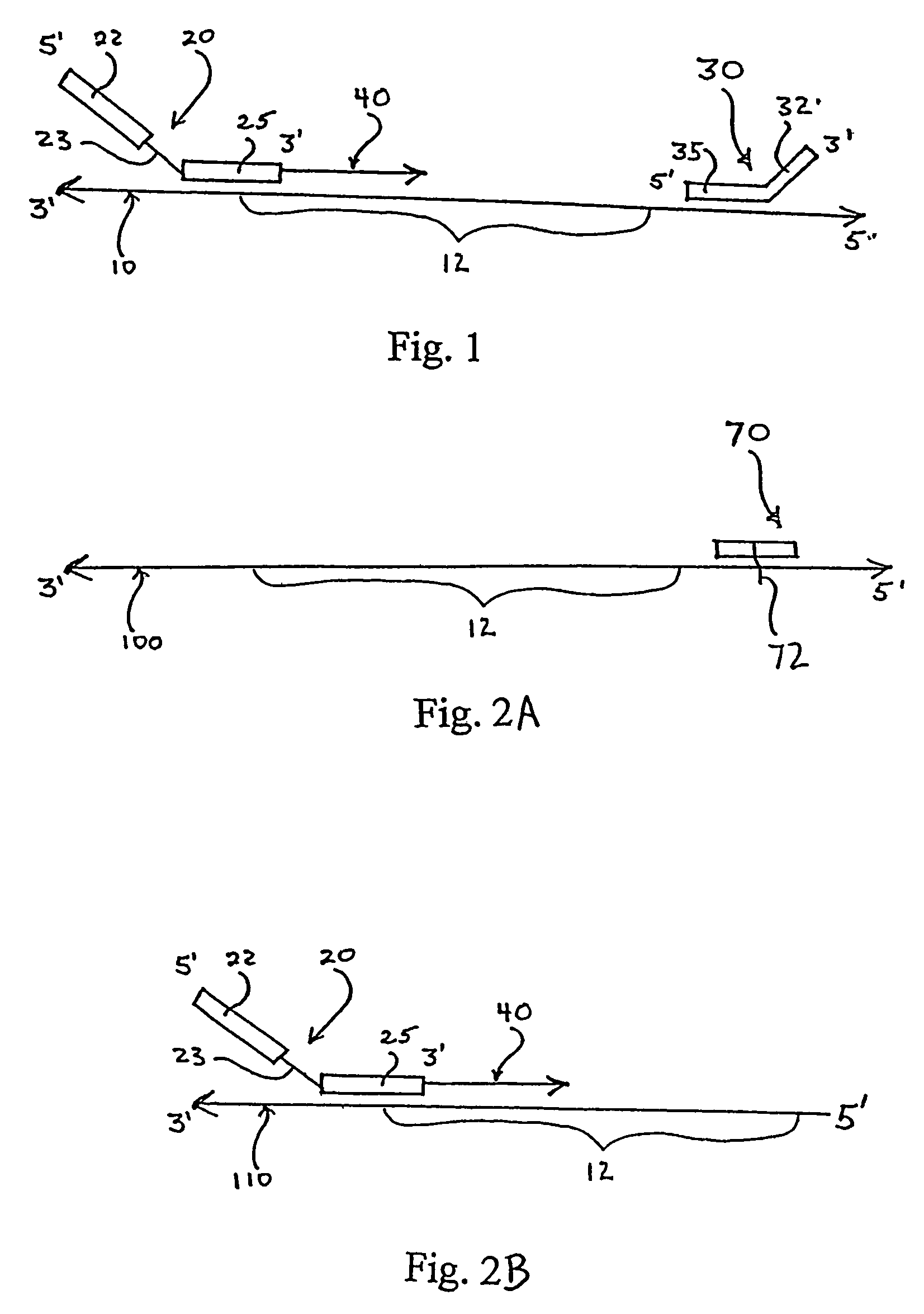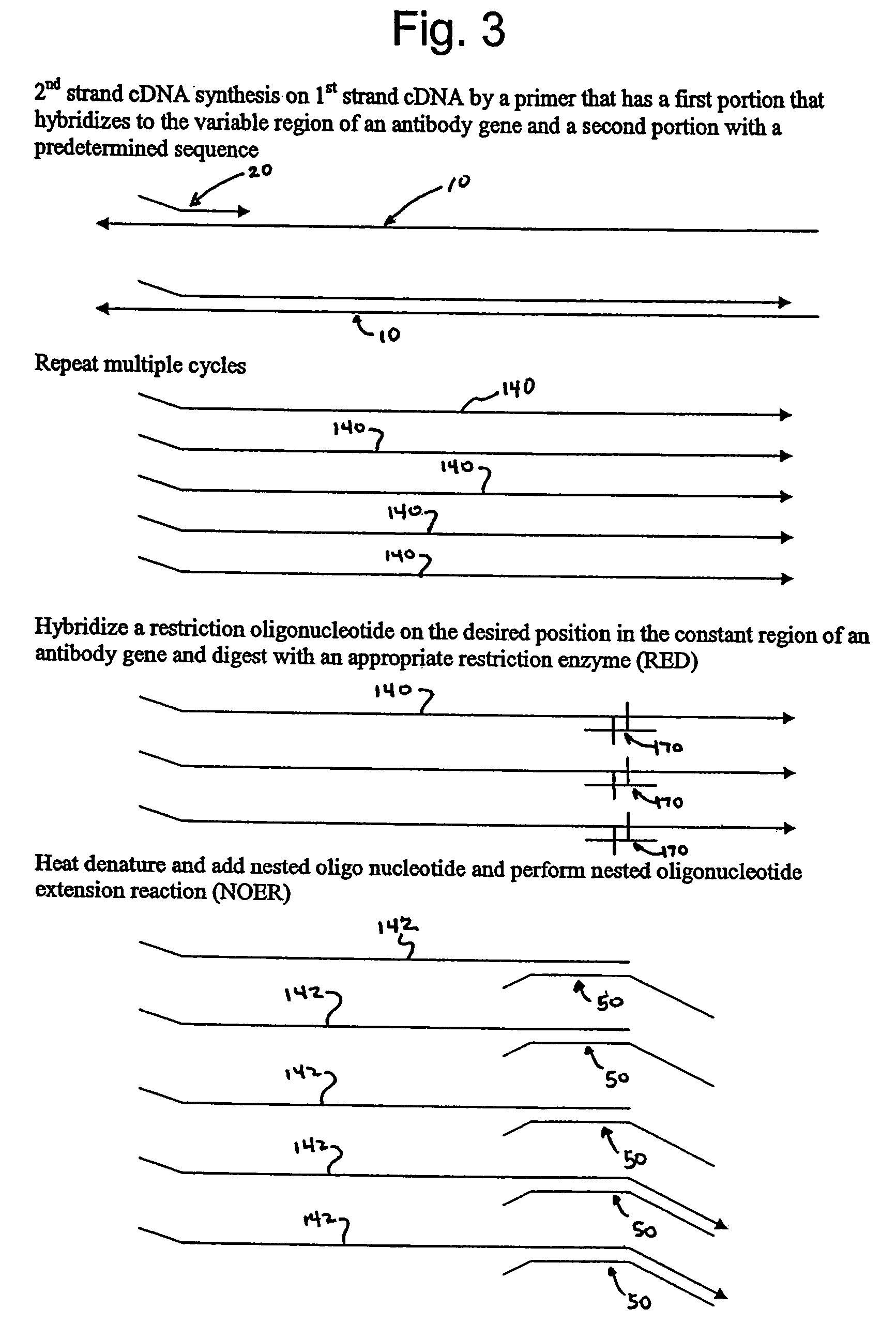Engineered templates and their use in single primer amplification
a template and template technology, applied in the field of engineered templates, can solve the problems of non-specific amplification, base amplification, description target amplification,
- Summary
- Abstract
- Description
- Claims
- Application Information
AI Technical Summary
Benefits of technology
Problems solved by technology
Method used
Image
Examples
example 1
Amplification of a Repertoire of IgM Heavy Chain Variable Genes
1st Strand cDNA Synthesis and Modification
[0046]Human peripheral blood lymphocyte (PBL) mRNA was used to generate traditional 1st stand cDNA with an oligo dT primer using SuperScript First-Strand Synthesis System for RT-PCR (Invitrogen Life Technologies, Carlsbad, Calif.) essentially according to kit instructions. The first stand cDNA product was cleaned up over a QIAGEN spin column (PCR Purification Kit from QIAGEN, Valencia, Calif.). A restriction oligonucleotide was added to the first strand cDNA in order to generate a double stranded DNA region that could be digested by the restriction endonuclease EcoR I. The sequence of the restriction oligonucleotide (CMEcoR I) was 5′ TCC TGT GAG AAT TCC CCG TCG 3′ (Seq. ID No. 1). The reaction was set up with 1st strand cDNA and 0.1 uM oligonucleotide. The sample was heated to 95° C. for 2 minutes and then held at 64° C. for two minutes to allow specific annealing to occur. An ap...
example 2
[0051]In order to clone VH products into a vector so that the native IgM CH1 constant region could be reconstituted, a site other than the EcoR I in CH1 was utilized for the 1st strand cDNA endonuclease digestion. As those skilled in the art will appreciate, when Taq polymerase is used for this protocol, a terminal A is added to many of the newly synthesized DNA strands. In order to maximize diversity, the presence of that terminal A was taken into account in the design of the nested oligonucleotide. However, the presence of that extra A results in the loss of the EcoR I recognition site. Analysis of the IgM constant region revealed other native restriction sites that could potentially be used for this method, such as Dra III. The result of using the Dra III native restriction site in the CH1 domain is that the upstream EcoR I site remains unmodified and can be used for cloning the heavy chain repertoire. The heavy chain inserts are cloned by Xho I and EcoR I into an appropriate vec...
example 3
[0058]Construction of a Phagmid Display Library From mRNA of a Hepatitis B Positive Donor.
1st Strand cDNA Synthesis and Modification for IgG Heavy and Kappa Light Chains
[0059]Human peripheral blood lymphocyte (PBL) mRNA from a Hepatitis B vaccinated donor was used to generate traditional 1st stand cDNA with an oligo dT primer. This was done using SuperScript First-Strand Synthesis System for RT-PCR (Invitrogen Life Technologies, Carlsbad, Calif.) according essentially to kit instructions. Restriction oligonucleotide “CGApaL I” for IgG or “CKSac I” for kappa light chain was added to the first strand cDNA in order to generate a double stranded DNA region that could be digested by the restriction endonuclease ApaL I for IgG or Sac I for kappa light chain. “CGApaL I” sequences is 5′CCA GCG GCG TGC ACA CCT TCC3′ (Seq ID No. 39). “CKSac I” sequence is 5′AGG GCC TGA GCT CGC CCG TC 3′ (Seq ID No. 40). The reaction was set up with 1st strand cDNA, 1 uM oligonucleotide, and appropriate amount...
PUM
| Property | Measurement | Unit |
|---|---|---|
| width | aaaaa | aaaaa |
| drug resistance | aaaaa | aaaaa |
| temperatures | aaaaa | aaaaa |
Abstract
Description
Claims
Application Information
 Login to View More
Login to View More - R&D
- Intellectual Property
- Life Sciences
- Materials
- Tech Scout
- Unparalleled Data Quality
- Higher Quality Content
- 60% Fewer Hallucinations
Browse by: Latest US Patents, China's latest patents, Technical Efficacy Thesaurus, Application Domain, Technology Topic, Popular Technical Reports.
© 2025 PatSnap. All rights reserved.Legal|Privacy policy|Modern Slavery Act Transparency Statement|Sitemap|About US| Contact US: help@patsnap.com



